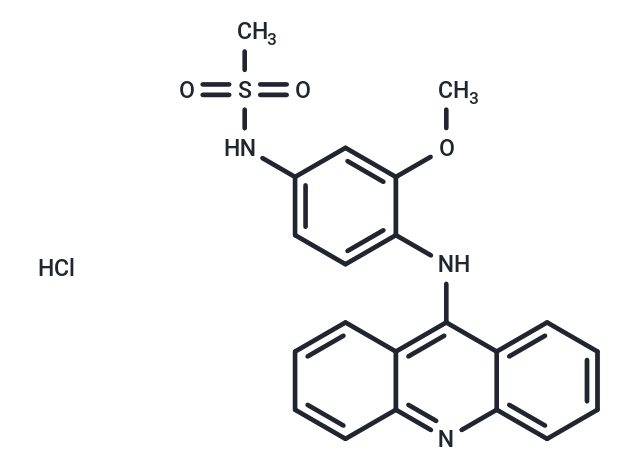Shopping Cart
- Remove All
 Your shopping cart is currently empty
Your shopping cart is currently empty

Amsacrine hydrochloride (acridinyl anisidide hydrochloride) is topoisomerase II inhibitor , is used in the treatment of acute myelogenous leukemia.

| Pack Size | Price | Availability | Quantity |
|---|---|---|---|
| 10 mg | $39 | In Stock | |
| 25 mg | $54 | In Stock | |
| 50 mg | $72 | In Stock | |
| 100 mg | $97 | In Stock | |
| 200 mg | $126 | In Stock | |
| 500 mg | $178 | In Stock | |
| 1 g | $262 | In Stock |
| Description | Amsacrine hydrochloride (acridinyl anisidide hydrochloride) is topoisomerase II inhibitor , is used in the treatment of acute myelogenous leukemia. |
| In vitro | Amsacrine hydrochloride blocked HERG currents in HEK 293 cells and Xenopus oocytes in a concentration-dependent manner, with IC50 values of 209.4 nm and 2.0 microm, respectively. HERG channels were primarily blocked in the open and inactivated states, and no additional voltage dependence was observed. Amsacrine caused a negative shift in the voltage dependence of both activation (-7.6 mV) and inactivation (-7.6 mV). HERG current block by amsacrine was not frequency dependent.?The S6 domain mutations Y652A and F656A attenuated (Y652A) or abolished (F656A, Y652A/F656A) HERG current blockade, indicating that amsacrine binding requires a common drug receptor within the pore-S6 region[1]. |
| In vivo | In animals treated with various doses of amsacrine (0.5-12 mg kg(-1)), significant increases in micronucleated polychromatic erythrocytes were observed at 9 and 12 mg kg(-1), with higher doses causing significant suppression of erythroblast proliferation. Amsacrine exhibits high incidences of clastogenicity and low incidences of aneugenicity[2]. |
| Cell Research | Voltage-clamp measurements of Xenopus oocytes were performed in a solution containing (in mM): 5 KCl, 100 NaCl, 1.5. CaCl2, 2 MgCl2 and 10 HEPES (pH adjusted to 7.4 with NaOH). Current and voltage electrodes were filled with 3 m KCl solution. For whole-cell patch-clamp recordings from HEK 293 cells, electrodes were filled with the following solution (in mM): 130 K-aspartate, 5.0 MgCl2, 5 EGTA, 4 ATP, 10 HEPES (pH adjusted to 7.2 with KOH). The external solution for these experiments contained (in mM): 137 NaCl, 4.0 KCl, 1.0 MgCl2, 1.8 CaCl2, 10 HEPES, 10 glucose (pH adjusted to 7.4 with NaOH). Amsacrine was prepared as 10 mm stock solution in DMSO and stored at -20℃. On the day of experiments, aliquots of the stock solution were diluted to the desired concentrations with the bath solution. HERG current amplitudes (recorded from Xenopus oocytes) were not significantly altered upon application of 1% DMSO (v v^-1; maximum bath concentration) for 20 min. In addition, DMSO did not affect HERG channel currents recorded from HEK 293 cells at concentrations up to 0.3% (maximum bath concentration in this study: 0.1% DMSO)[1]. |
| Alias | m-AMSA hydrochloride, acridinyl anisidide hydrochloride |
| Molecular Weight | 429.92 |
| Formula | C21H20ClN3O3S |
| Cas No. | 54301-15-4 |
| Smiles | Cl.COc1cc(NS(C)(=O)=O)ccc1Nc1c2ccccc2nc2ccccc12 |
| Relative Density. | no data available |
| Storage | Powder: -20°C for 3 years | In solvent: -80°C for 1 year | Shipping with blue ice. | ||||||||||||||||||||
| Solubility Information | DMSO: 4.3 mg/mL (10 mM), Sonication is recommended. | ||||||||||||||||||||
Solution Preparation Table | |||||||||||||||||||||
DMSO
| |||||||||||||||||||||

Copyright © 2015-2025 TargetMol Chemicals Inc. All Rights Reserved.